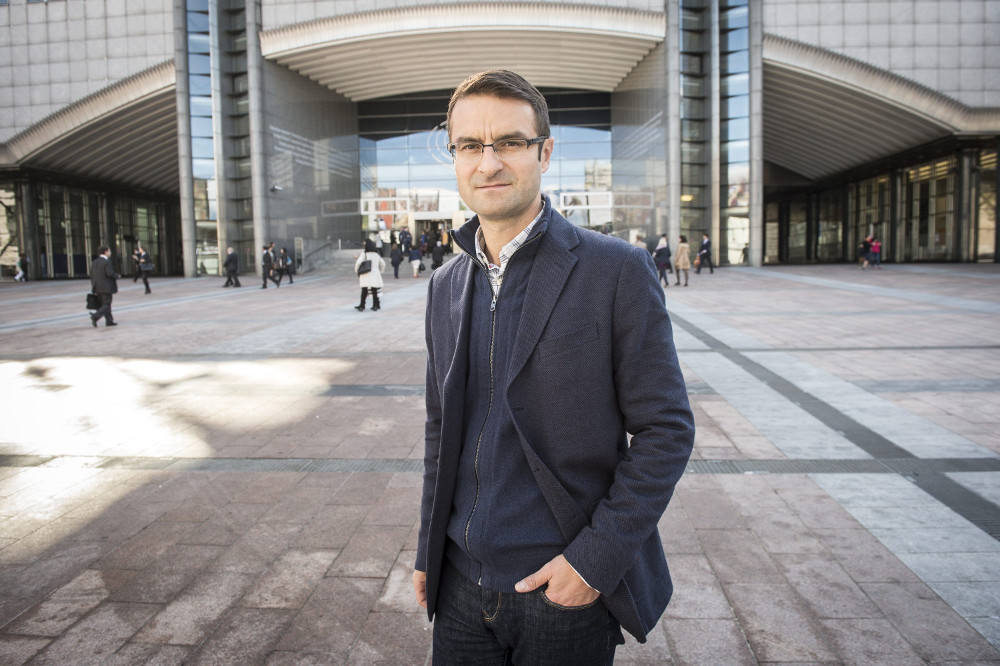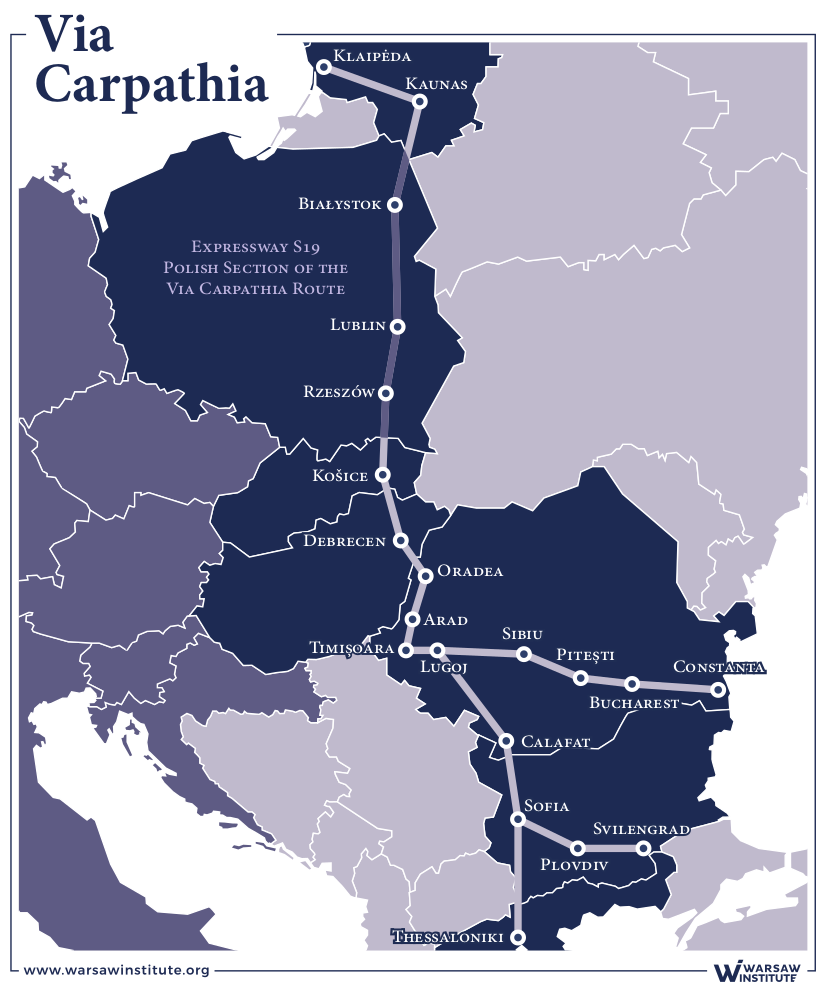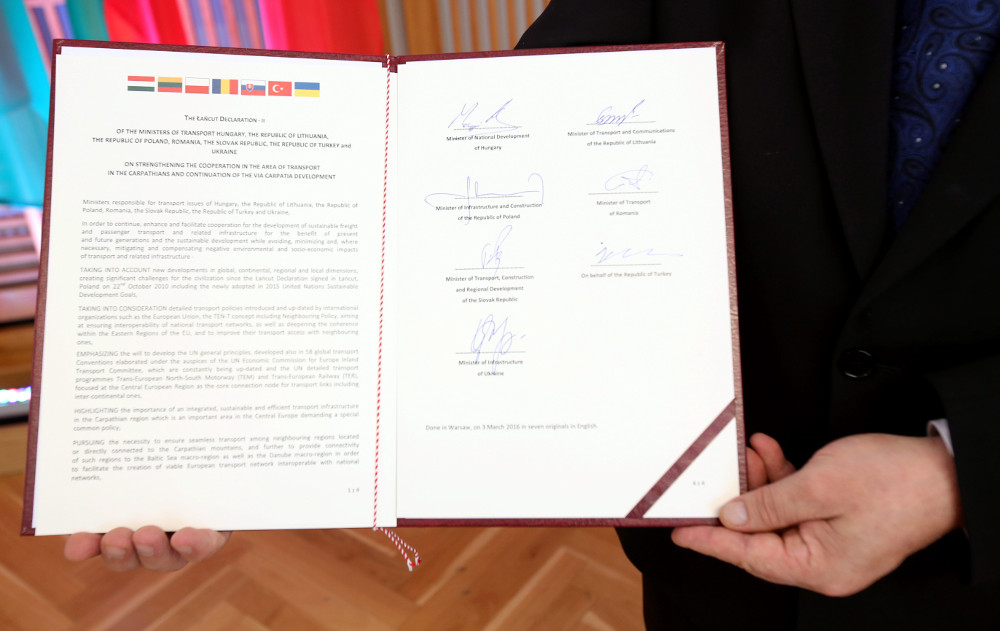THE WARSAW INSTITUTE REVIEW
Date: 13 March 2018 Author: Tomasz Poręba
Via Carpathia – An Investment in the Future
Just a few years ago, knowledge of the Via Carpathia (a north-south, trans-European road route) was minimal, if not an entirely foreign concept in Brussels.

This project was not recognized as a major international investment nor was it treated as a priority. The Via Carpathia did not exist in the imaginations of the “Brussels elite”. Over years of consistent (even arduous) work, pressure and commitment at many decision-making levels, the perception of this project was radically changed as was the attitude of the European Commission towards it. Through small steps in the absence of support from the then-current Civic Platform government, and even in the face of frequent and ostentatious opposition, the Via Carpathia was successfully elevated to an entirely new level of importance.
Let us start from the beginning. The idea of creating the Via Carpathia route was initiated by Poland in 2006 in Łańcut, when ministers from Lithuania, Poland, Slovakia and Hungary, under the patronage and in the presence of the President of the Republic of Poland Lech Kaczyński, signed the first joint Łańcut Declaration on the extension of TEN-T (Trans-European Transport Networks) through the Via Carpathia. In 2010, three more countries joined this initiative: Romania, Bulgaria and Greece. During an international conference, the transportation ministers of seven countries through which the route runs signed a new version of the Łańcut Declaration in which they pledged to take all possible steps to incorporate the route along its entire length (Klaipeda – Kaunas – Białystok – Lublin – Rzeszów – Kosice – Miskolc – Debrecen – Oradea – Logoj – Calafat/Constanta – Sofija/Svilengrad – Thessaloniki) to the TEN-T network as part of the amendment of the EU law on trans-European transport networks. The last declaration on strengthening cooperation in the area of transport through the Carpathians and further development of Via Carpathia was signed in March 2016.
In Poland, the route will cover nearly 700 kilometers and run along the S8 and S19 roads, and run from the border with Lithuania in Budzisko, through Białystok, Lublin and Rzeszów, to the border with Slovakia in Barwinek. Its Subcarpathian segment is the S19 expressway. In October 2011, after completing two-year consultations with member states, including Poland, the European Commission published the “Union Guidelines for the Development of the Trans-European Transport Network”. Unfortunately, sections of the Via Carpathia were only partially accounted for in the core TEN-T network, to be completed by 2050, with no real guarantee of funds being secured for construction. After two years of negotiations, the Via Carpathia was also omitted from the list of investment priorities for the TEN-T network in the final version of the 2013 regulation.
From the moment the Łańcut Declarations were signed in 2006 and 2010, the Civic Platform government did not make any effort to make the Via Carpathia eligible for funding under the EU budget; nor did they take advantage of the opportunity offered by the amendment of the trans-European transport network regulations, which determined the most important EU transport priorities for implementation by 2023. In 2010, the Civic Platform government submitted a funding proposal for only one section of the S19 road on the Rzeszów–Lublin route, which was included with the core network projects. The remaining sections were written into the so-called supplementary network to be completed by 2050, with no guaranteed funds or budget allocation. The regulation amendment was successfully taken advantage of by other countries along the Via Carpathia, such as Romania, Bulgaria and Greece, which accounted for most of the road segments within the core network.
The Via Carpathia needed immediate and effective lobbying within the EU, so to popularize the idea and to show its added value to the Union’s entire eastern flank. Hence my commitment and attempt to use all possible instruments available to members of the European Parliament, to raise awareness among colleagues from other member states, as well as the officials of the European Commission and to finally put this investment into a leading place on the EU agenda.
That is why in November 2011, when the European Parliament started work on the future shape of the TEN-T, I submitted five amendments calling for the inclusion of the Via Carpathia route along the entire core network (Civic Platform members did not submit any amendments on this matter at the transport committee level). In October 2012, I organized a conference in the European Parliament in support of the Via Carpathia with the participation of transportation ministers, representatives of regions through which the route runs, ambassadors, MEPs, experts and European Commission representatives (despite the request for support of the initiative – neither representatives of the Polish government, nor Civic Platform MEPs, appeared).

In June 2013, I again submitted amendments regarding the Via Carpathia, this time during a plenary session. In June 2014, at my initiative, the European Parliament decided to deal with the issue of construction of the Via Carpathia and to consider a petition from one of the residents of Stalowa Wola, Poland. The petition made it to the European Commission, which said that it was possible to build a road with EU funds, but the Polish government should take the lead on the initiative. As the referrer and defender of the petition, I persuaded the Petitions Committee to address this matter. As a result, the parliament intended to send a special mission to the Subcarpathia region to prepare a report to the European Parliament on the state of the S19 road. Unfortunately, at the request of MEPs of the Civic Platform, the Petitions Committee decided to close the Via Carpathia petition. Poles themselves blocked a valuable initiative to build a road which would improve transportation access to our country. Civic Platform MEPs (Julia Pitera and Jarosław Wałęsa) stated that nothing could be done in this case and appealed for the petition to be closed once and for all. They also stressed that Subcarpathia is one of the best financed regions in Poland and questioned the validity of the investment.
As vice-chairman of the European Parliament’s Commission on Transport and Tourism, I also promoted the idea of building the Via Carpathia on the forum of my committee. And so, on my initiative, in December 2014, a hearing on transportation routes in Central and Eastern Europe was held. The purpose of the hearing was to show the need to increase the quantity and quality of transport connections in this part of Europe, and that infrastructure improvement and construction of the Via Carpathia would serve as an important incentive for the development of these areas, which would be a kind of transportation backbone of Central and Eastern Europe. One of the foundations of the EU is sustainable development and therefore the European community should take care of its poorest regions first and foremost. The hearing was aimed at showing the Polish government that this project is in line with the EU’s cohesion policy and has a chance to be implemented in the coming years, if the Polish authorities have the will.
I also tried to convince multiple EU transportation policy and cohesion policy commissioners to the absolute necessity to build the Via Carpathia route. Starting with Siim Kallas, European Commissioner for Transport Policy (2009–2014), and Maros Šefčovič, Vice-President of the European Commission to Violeta Bulc, the current European Commissioner for Transport and Corina Cretu, European Commissioner for Regional Policy. I must honestly admit that the need for the implementation of the Via Carpathia project found much more understanding in Brussels than back home. One commissioner after another was looking for solutions and budget possibilities opening the way to the construction of the Via Carpathia, suggesting the preparation of appropriate and convincing documentation and the financial framework for this investment. In the meantime, my appeals to (then) Deputy Prime Minister Elżbieta Bieńkowska, Prime Minister Ewa Kopacz and Minister of Infrastructure and Development Maria Wasiak, about submitting the Via Carpathia project to realization under the new EU Infrastructure Investment Plan of the Jean-Claude Juncker, President of the European Commission, remained unanswered. Brussels gave a clear signal that tools exist to finance this investment. All that was necessary was for the Polish government to submit the project to bids.
Eastern Poland was consistently ignored by the Civic Platform government for EU-funded transportation investments. It was clear that the government stubbornly sought to marginalize eastern Poland and continued the policy of neglecting those regions. The Civic Platform-Polish People’s Party coalition government sought to concentrate development around several major metropolitan centers, located mainly in western Poland, through access to EU funding and the implementation of key projects. The rest of the country was to be condemned to the peripheries. This approach contradicted one of the main principles of the EU – sustainable development – and the spending of EU funds to equalize the differences between regions, not deepen them. Unfortunately, the eight-year rule of the previous coalition was largely lost time for the infrastructural development of eastern Poland.
In time, however, our efforts began to bring visible results, and the idea of building the Via Carpathia was reflected in official documents of the European Parliament. In the end, it was possible to imbue the irreversible necessity to implement this investment into the consciousness of the EU institutions. And so, on my initiative, for the first time in an official document of the European Parliament, the need to build the Via Carpathia route was recognized. The Parliament’s Regional Development Committee adopted an opinion underlining the need to develop North-South transport corridors on the example of the Via Carpathia to better connect the northern and southern parts of the continent, which would help to reduce development disparities between regions.
The European Parliament also adopted my report on transport infrastructure in Central and Eastern Europe. This is the first comprehensive document devoted entirely to the development of infrastructure in this region. The report included a call to the European Commission and member states to address the urgent need to strengthen road infrastructure along the EU’s eastern border, including the construction of the Via Carpathia as soon as possible.
The Parliament has accepted the arguments that through the Via Carpathia, the EU’s peripheral regions will gain the opportunity for accelerated development and will more quickly match the more developed areas of the Union. The construction of the route will also stimulate the inflow of investments, increase entrepreneurship and improve the security of the entire EU, especially in the context of the armed conflict in Ukraine. In the report, the Parliament encourages member states to prepare a financial framework for this project using all possible instruments, such as the Connecting Europe Facility or the European Fund for Strategic Investments, and promises in the next revision of the TEN-T guidelines to do its utmost to ensure that the Via Carpathia route has been fully integrated into the core network.
I also initiated in the European Parliament the collection of signatures under a written declaration on the construction of the Via Carpathia. The Declaration on Via Carpathia stresses that the route plays an important role in stimulating growth in the eastern regions of the Union, which often experience socio-economic problems. Its construction, renovation and extension would allow for the reduction of differences in the level of development between EU regions, by supporting new jobs and competitiveness. The investment would also strengthen economic and social relations with neighboring EU countries, especially in the context of the future EU enlargement to the East. In the declaration, we call on the European Commission to reflect on the role of Via Carpathia in a holistic transport policy and to include it in the TEN-T core network and thus facilitate access to funds.
Meanwhile, a change of government was needed in our country for eastern Poland to finally be treated fairly in terms of EU investments. The elections won in 2015 by Law and Justice brought about landmark decisions regarding the financing of the construction of the Polish section of Via Carpathia along the S19 road. The S19 has become a strategic transport investment for the Polish government. Tenders for the construction of a road towards Lublin were announced, a part of the Lublin beltway along the S19 road was opened, the second stage of the tender for the Stalowa Wola and Niska beltways and the Janowskie-Nisko Forest section have started. At the same time, the funds for S19 to Babica were guaranteed, and a positive environmental decision was issued for the construction of the entire Rzeszów-Barwinek section. Furthermore in December 2016, the government awarded nearly 70 million PLN for hydrological and geological works on this route. In June 2017, the Council of Ministers adopted a resolution in which the financial limit of the National Road Construction Program for the years 2014–2023 (with a perspective up to 2025) was raised from 107 billion to 135 billion PLN. The increase in funds is mainly caused by the need to finance road investments in eastern Poland, especially the construction of the Via Carpathia, to which the government will allocate 21 billion PLN.
I have no doubt that nothing will stop the construction of Via Carpathia now. The project is supported today by the majority of countries in the eastern EU. The construction of this road will mean not only the improvement of transport accessibility to eastern Poland, but also an acceleration in the development of the eastern flank of the EU, including the inflow of investments, improvement in security and growth of entrepreneurship. The Via Carpathia is also an opportunity for Polish ports. The route, which in Poland will run from Barwinek through Rzeszów to Lublin, then along the S17 route to Warsaw, and from the capital via S7 and A1 to Polish ports, will allow Hungarians, Romanians, Slovaks and Bulgarians to send goods and services to ports in Poland, contributing to their development. The Special Economic Zone EURO-PARK MIELEC is also located along the Via Carpathia. The new route will be an important support for enterprises operating in the zone.

The Via Carpathia, due to its course, is particularly important for all the provinces of eastern Poland and provides an opportunity to accelerate the development of this part of the country. Roads S8 and S19 are a key element conducive to increasing the transport accessibility of the eastern part of Poland, both nationally and within the EU, and are conducive to its economic growth.
The basic problem of eastern Poland is the very low level of economic, social and territorial cohesion. For this reason, projects increasing the territorial accessibility of this area can definitely contribute to strengthening the competitiveness of the entire region. The improvement of transport accessibility will significantly increase economic investment, which will contribute to the intensification of the economic development of this area.
Transportation infrastructure is the basis for the functioning of the economy and its development should be shaped with particular concern for modernity and efficiency. Transportation is an indispensable element of critical infrastructure, a guarantor of state security. By this definition, the Via Carpathia takes on new meaning for the security of the entire EU. The construction of the S19 road also takes on special significance in the context of the armed conflict in Ukraine. Well-connected eastern regions of our country, thanks to a highly developed transportation infrastructure, will undoubtedly increase Poland’s security.
The construction of the S19 road also fits in with the logic of the functioning of the EU, whose main objective is to equalize development opportunities between the eastern and western regions of Europe. Today eastern Poland is a blank space on the continent’s transportation map.
Finally there is still a chance to realize the Via Carpathia. According to the provisions of Article 54 of the European Parliament’s decree and EU Council Regulation 1315/2013, the next review of the development of the TEN-T will be carried out by December 31, 2023, when the European Commission, after consulting the member states and European coordinators, will verify the level of implementation of the transportation network. As part of this process, an assessment will be made of the need to introduce changes to the above regulation and the core network itself. The sections of the Via Carpathia project should be submitted by Poland and other interested member states as parts of the TEN-T core network, before the European Commission issues its statement, so that the entire route is an integral part of future maps from the outset. To this end, the coalition of signatories to the March 2016 declaration should be utilized and the European Commission should be presented with a common case that will convince the European Commission to requalify from supplementary to integral these sections of the Via Carpathia.
_________________________________
All texts published by the Warsaw Institute Foundation may be disseminated on the condition that their origin is credited. Images may not be used without permission.














